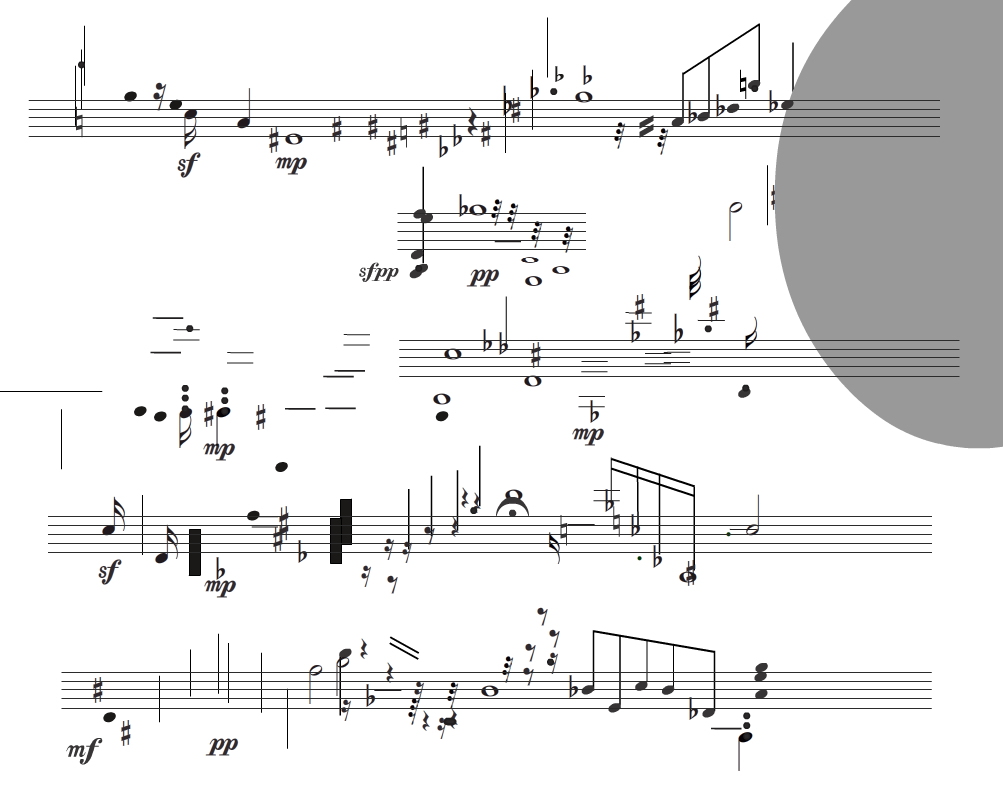I perceive the outside world surrounding me as an unforeseen self-motion of the “projection surface: world”;
Perceptions as results of thinking, consciousness or interpretation not as their prerequisite.
Signs as reduction and attempt of objectification in a generally flowing movement.
As a consequence of this thought experiment, the composition “Nomos Alto” is created.
The score starts to change and thus refuses a traditional interpretation, since the sign system has already developed and changed during the interpretation process and reacts – metaphorically – to an intertextuality.
Text (score) and interpretation become virtually indistinguishable.
In the triad: system of signs (score) – object (work) – interpretation, the score is initially a seemingly certain tangible materiality.
The performance refers only in a limited way to the work, as there are potentially infinite interpretations:
Different interpreters relate to previous interpretations and thus to the relationship between work and score.
Previous performances become the “sign” of this new “object”, the semiotic process becomes an endless web of relations.
The understanding of the work of art is moving, becomes more vulnerable, more unfathomable, brings the process into motion, but is always an initiation point on the interpretation.
Apart from the practical interpretation, only ink and paper exist.
The play of interpretation does not only include the preceding interpretations, but also other influences, including non-musical ones; a whole “encyclopedia” (*1) of influences.
This also happens in a compositional process !
A web of references – composition and interpretation approach each to each other by becoming an intertext.
“As one can now assume, in reality there are no sign systems that function completely precisely and functionally unambiguously on their own. (…) They only function because they are integrated into a certain semiotic continuum, which is filled with semiotic structures of different types, which are at different organizational levels.
We want to call such a continuum (…) a semiosphere.” (*2)
Background knowledge, experience, influences, analysis and cultural phenomena are inseparably interwoven.
Fading out intertextuality and a (violent) reduction of the musical text to seemingly objective conditions reduces the wealth of possibilities.
However, any statement is interpretation.
Text and interpretation are indistinguishable.
This calls into question the concept of repeatability at least :
instead, there is an exciting perspective: the inevitable interaction of text and interpretation can create additional sense and new possibilities.
(*1) Umberto Eco, Semiotica e filosofia del linguaggio, Torino 1984, 55-140
(*2) Jurij M. Lotman, Über die Semiosphäre, in: Zeitschrift für Semiotik 12 (1990), Heft 4, 288
many thanks to Benno Ganz for translation
Die mich umgebende Außenwelt nehme ich als unvorhergesehene Eigenbewegung der “Projektionsfläche Welt” wahr; Wahrnehmungen als Ergebnisse von Denken, Bewusstsein oder Interpretationen nicht als ihre Voraussetzung. Zeichen als Reduktion und Versuch der Objektivierung in einer allgemein fließenden Bewegung.
Als Konsequenz aus diesem Gedankenexperiment entsteht “Nomos Alto”. Die Partitur gerät in Bewegung und verweigert sich damit einer traditionellen Interpretation, da das Zeichensystem sich während des Interpretationsprozesses schon weiter entwickelt und verändert hat und -metaphorisch- auf eine Intertextualität reagiert. Text (Partitur) und Interpretation werden quasi ununterscheidbar.
Im Dreiklang: Zeichensystem (Partitur) – Objekt (Werk) – Interpretation- ist die Partitur zunächst eine sicher scheinende greifbare Materialität, aber eine Aufführung verweist nur beschränkt auf das Werk, da es potentiell unendlich viele Interpretationen gibt: Verschiedene Interpreten beziehen sich auf vorangegangene Interpretationen und somit auf das Verhältnis zwischen Werk und Partitur. Vorausgehende Aufführungen werden zum “Zeichen” dieses neuen “Objektes”, der semiotische Prozess wird dabei zu einem unendliche Netz von Relationen. Der Werkbegriff gerät in Bewegung, wird angreifbarer, unfassbarer, bringt aber den Prozess in Bewegung, ist Anlass und Ausgangspunkt aber immer abhängig von der Interpretation. Außerhalb ihrer existiert nur Tinte und Papier.
Das Spiel der Interpretation bezieht aber nicht nur die vorausgegangenen Interpretationen mit ein, sondern auch andere, auch außermusikalische Einflüsse mit ein; eine ganze “Enzyklopädie” (*5) von Einflüssen. Dies geschieht ebenso im kompositorischen Prozess ! Ein Netz von Verweisen – Komposition und Interpretation nähern sich aneinander an indem sie zum Intertext werden.
“Wie man jetzt voraussetzen kann, kommen in der Wirklichkeit keine Zeichensysteme vor, die völlig exakt und funktional eindeutig für sich alleine funktionieren. (…) Sie funktionieren nur, weil sie in ein bestimmtes semiotisches Kontinuum eingebunden sind, das mit semiotischen Gebilden unterschiedlichen Typs, die sich auf unterschiedlichem Organisationsniveau befinden, angefüllt ist. Ein derartiges Kontinuum wollen wir (…) als Semiosphäre bezeichnen.” (*6)
Hintergrundwissen, Erfahrung, Einflüsse, Analyse sowie kulturelle Erscheinungen sind untrennbar miteinander verwoben. Eine Ausblendung von Intertextualität und eine (gewaltsame) Reduktion des musikalischen Textes auf scheinbar objektive Gegebenheiten reduziert den Reichtum an Möglichkeiten. Jede Feststellung ist jedoch Interpretation. Text und Interpretation sind nicht zu unterscheiden. Dies stellt das Konzept von Wiederholbarkeit zumindest in Frage: statt dessen ergibt sich eine spannende Perspektive: die unvermeidliche Interaktion von Text und Interpretation kann zusätzlichen Sinn erzeugen und neue Möglichkeiten erschaffen!
(*1)Vgl. Umberto Eco, Semiotica e filosofia del linguaggio, Torino 1984, 55-140
(*2) Jurij M. Lotman, Über die Semiosphäre, in: Zeitschrift für Semiotik 12 (1990), Heft 4, 288




